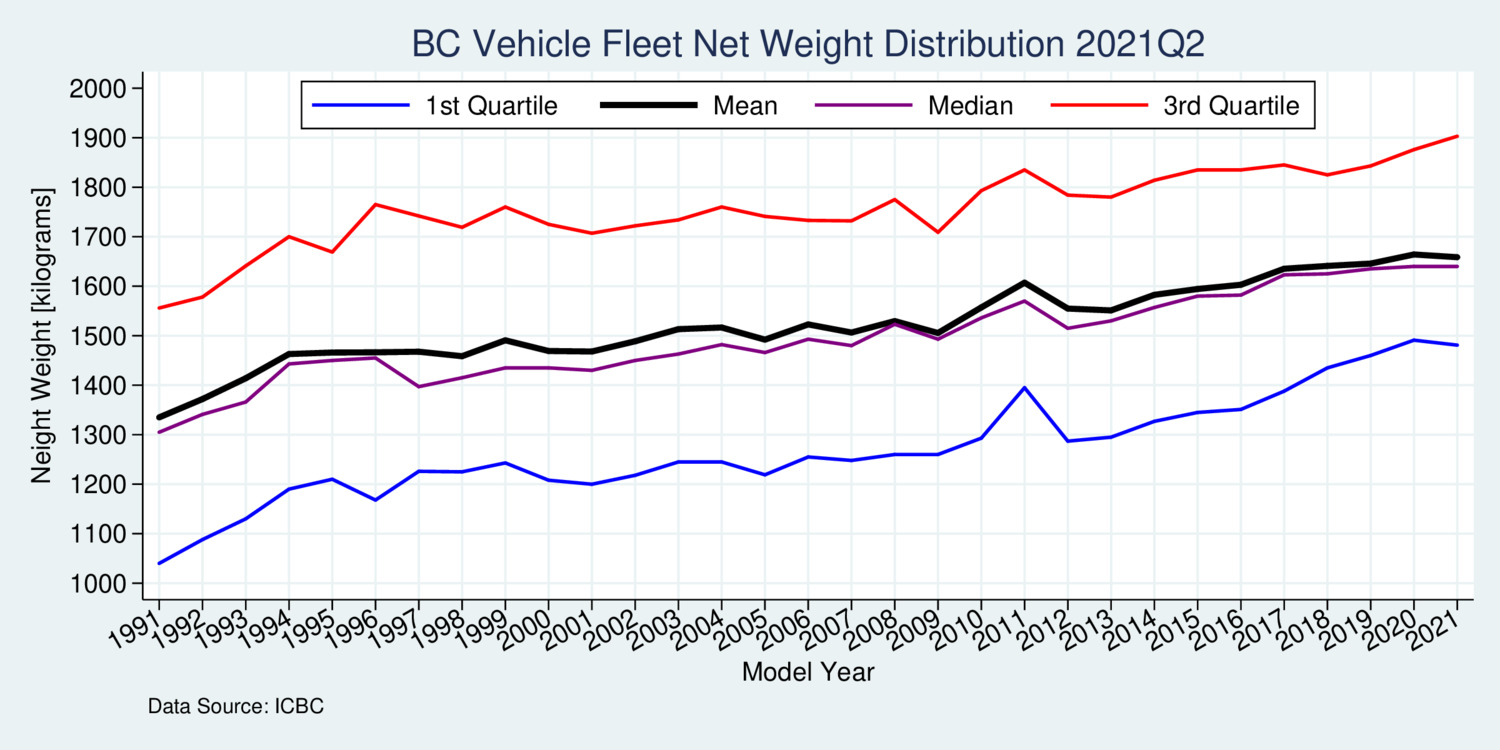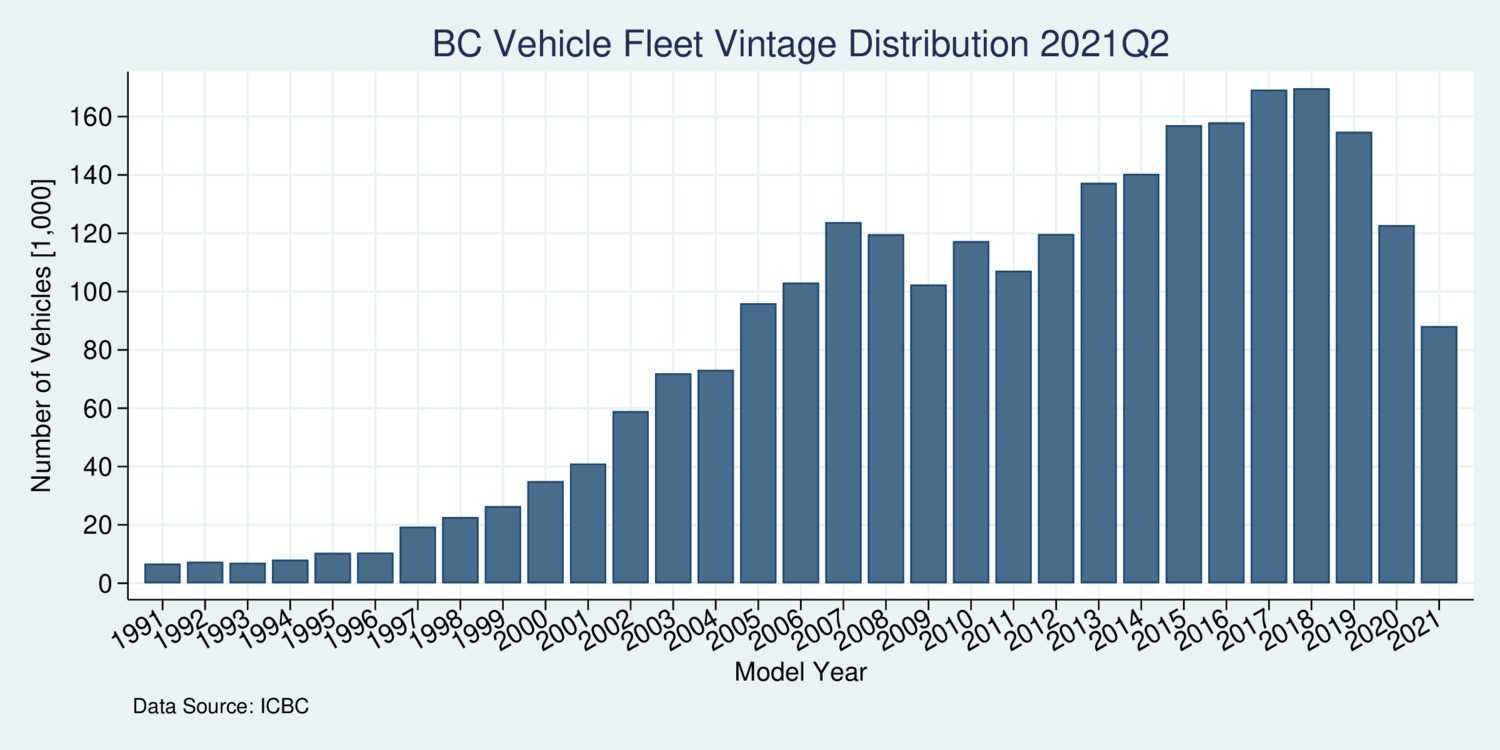It has often been observed that passenger cars are getting bigger and heavier. This trend is certainly true for British Columbia as well. Part of my current research is investigating the BC vehicle fleet, and the trend towards heavier vehicles is obvious. The chart below shows the weight distribution of the current fleet (as of June 30, 2021). What is clearly visible is the upward trend: newer vehicles are on average heavier than older vehicles that are currently being driven on roads in British Columbia.

click on image for high-resolution PDF version
Vehicles from model year 1980 had a net weight (i.e., without passengers or items) of 1440 kilograms. By 2000 this had reached 1469 kilograms, an increase of 29 kg or roughly 2%. Vehicles with model year 2020 had an average weight of 1664 kilograms, a whopping 195 kg increase (i.e., 13%) over this 20-year period.
Just looking at model years 2002-2021, each new model year is about 9.84 kilograms heavier than the previous model year. This trend is even more pronounced for smaller (compact, subcompact) vehicles. The first quartile of the distribution increases by 14.4 kilograms with each model year, while the third quartile of the distribution increases with just 8.5 kilograms with each model year. This means that the distribution is becoming slightly narrower. This compression trend is not statistically significant except for the last few years.
The downside of vehicles getting heavier is obvious: heavier vehicles require more energy, and thus improvements in fuel efficiency for specific vehicles (what economists call a technique effect) are offset by the trend towards heavier vehicles such as SUVs (what economists call a composition effect). This means that engineering progress has not helped as much with reducing fuel consumption as would have been the case if motorists still drove cars with lesser weight on average. The popularity of light trucks (SUVs, pick-up trucks) has been holding back environmental gains.
On the upside, larger and heavier vehicles tend to be safer in collisions, for a number of reasons. This relationship has been well established by research in an US-NHTSA 2012 report and other work. In a collision, the weight gap between two colliding vehicles matter. However, newer generations of smaller vehicles have been compensating for this through improved safety designs. The "weight advantage" in a collision appears to become smaller. Lighter vehicles can break faster, and with the emergence of fast-acting collision detection sensors in vehicles, lighter cars may be able to avoid a collision or reduce the impact speed.
My economist colleagues Antonio Bento, Kenneth Gillingham, and Kevin Roth have looked at the relationships between fuel economy, weight dispersion, and accident fatalities in much greater depth in their NBER working paper from July 2017. They find that tightening fuel-economy standards (CAFE) has been beneficial for reducing fatalities.
Some cars on BC's roads are actually quite old, and not just collector vehicles. This is illustrated in the next diagram, which shows the vintage distribution of the current fleet by model year. The 2020 and 2021 models are still being sold as new vehicles, and thus the last two model years are still accumulating. Older vehicles are subject to attrition, mostly due to scrappage. BC has a slightly long-aged fleet compared to other provinces because of its mild winter climate. There is less rust, and less wear and tear. The average car on BC's road is about 11.9 years old.

click on image for high-resolution PDF version
The chart above shows a peak of about 170,000 vehicles for model years 2017 and 2018, and fewer models for each earlier vintage. Statistics Canada also keeps track of new motor vehicle sales. In 2018 and 2019, there were 228,258 and 216,031 new cars sold. Mostly due to the pandemic, sales dropped to 179,400 vehicles in 2020 — a 17% drop compared to the previous year.
An important question about the electrification of mobility is how long it takes to turn over significant parts of the vehicle fleet, given an increasing share of EV sales in total sales. After 2035 all new vehicles are mandated to be zero-emission vehicles (ZEVs). Some modeling is required to predict the shares of ZEVs on our roads. More on this topic in a future blog.
![[Sauder School of Business]](logo-ubc-sauder-2016.png)
![[The University of British Columbia]](logo-ubc-2016.png)